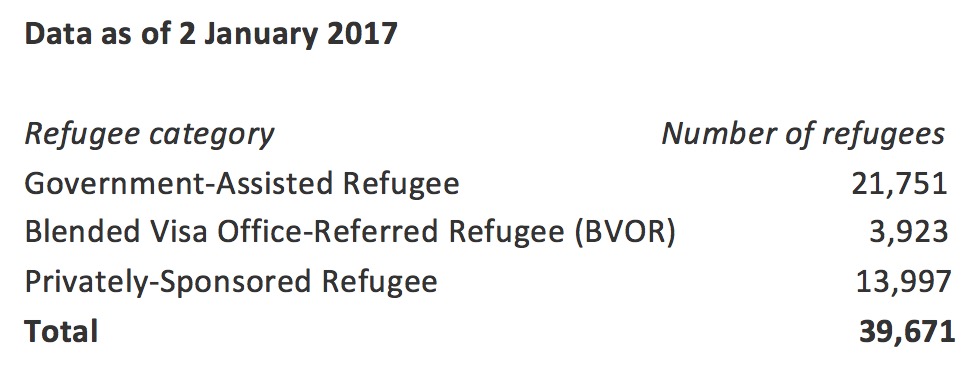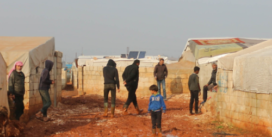- Fall Newsletter, 2025, Issue 15
- Using International Online Learning Modules to Engage Students in the Study of Critical Global Issues
- Upcoming Book Launch: Hearts of Freedom
- Announcing winners of the 2025 CARFMS Essay Contest
- The New York Declaration for Refugees and Migrants and its two Global Compacts: Addressing the Symptoms or the “Root Causes” of Forced Displacement?*
Excluding Syrians, by Howard Adelman
Refugees are doubly victimized, first by the warriors and ideologues that forced them to flee their homelands if they wanted to survive, and then, a second time, when persons in authority like the malignant narcissist and serial liar, Donald Trump, placed an indefinite ban[1] on Syrian refugees coming to the United States, and then a “temporary” 90-day ban on refugees coming to the United States from six other countries – Iraq, Iran,[2] Libya, Somalia, Sudan and Yemen in his notorious executive order issued 27 January 2017, “Protecting the Nation from Foreign Terrorist Entry into the United States.”
Visas will not be issued to anyone from those countries. Even those traveling with valid visas may be and were turned back or detained. Many others, including, initially, those with Green Cards, were not allowed to take their seats on airplanes on which they had booked travel.
It just happens that these seven dangerous “Muslim” countries are all ones which the U.S. has waged war against and even actually bombed, but does not include Saudi Arabia, the source of the majority of the 9/11 terrorists and a country in which Donald Trump has financial interests, nor Pakistan, the home country of one of the very few Islamicist terrorists who have committed heinous crimes within the United States in the last eight years.[3] It also just happens that not one of those seven countries nurtured a single terrorist who committed a terrorist act on American soil.
Of the relatively small number of refugees that the U.S. planned to take in during 2017, 10,000 slots targeted for Syrians were recently increased to approximately 20,000 by the outgoing Obama administration.[4] All 20,000 will now go unfilled. In contrast, in 2015 even under the Harper regime, Syrians constituted the group of refugees with the highest numbers coming to Canada. For ten years, Canada’s average intake of refugees had been about 25,000 annually, about 10% of the overall immigrant intake. In 2015, almost 60% came as asylum seekers with their family members, over 40% as either government or privately sponsored refugees, the latter making up about one-third of that 40%.
In 2016, the Harper government had planned an intake of 10,000 refugees. When the Liberal Justin Trudeau government was elected, it immediately announced some ambitious plans for the intake of Syrian refugees. As of the end of 2016, Canada took in almost 40,000 refugees under this new initiative, twice that even planned by the Obama government and now literally infinitely more than will be allowed entry by the Trump administration
The breakdown was as follows:
The number estimated for 2017 is expected to be about 23,500 of the 43,500, the reduction coming overwhelmingly from the government-sponsored class. Just after The Donald issued his executive order, an initiative was begun almost immediately for Canada to admit 20,000 more Syrian refugees than planned for 2017 on a matching formula whereby the government will take in the same number of government-sponsored Syrian refugees, up to 10,000 in 2017, as the number of Syrian refugees sponsored by the private sector. There need not be, any deliberate explicit connection to Trump’s embargo. The day after Donald Trump issued his executive order, Justin Trudeau tweeted, “To those fleeing persecution, terror & war, Canadians will welcome you, regardless of your faith. Diversity is our strength #WelcomeToCanada.” He walked that fine line by praising Canadian values rather than criticizing current American policy.
The current Canadian Minister of Immigration, Refugees and Citizenship, Ahmed Hussen, who himself fled war-torn Somalia at the age of 16, under the plain reading of the Trump executive order would not be allowed entry to the United States if he were not traveling on a diplomatic passport. Hussen issued a policy directive in response to the Trump decree that Canada would issue temporary residency permits to those stranded because of Trump’s order, but that would do nothing for Canadian citizens and permanent residents born in those seven countries. Later, the State Department, in apparent direct contravention of the wording of Trump’s executive order, declared that the ban would NOT apply to Canadian citizens with dual passports or to Canadian permanent residents with passports from those countries.
What has happened to the carefully constructed international refugee system developed in the aftermath of World War II that has enabled millions of refugees in every region to find safety in other countries? What has happened to the country that for decades welcomed refugees, that until very recently resettled millions of refugees from regions in turmoil and led initiatives in inspiring other countries to engage in responsibility-sharing?[5] That country has now fallen into the hands of a president governed by a radical nationalist ideology who builds policy on paranoia and prejudice rather than any analysis of data or of consequences. Make no mistake about it, his policy has as little to do with the threat of terrorism as the connection between drinking Coca-Cola and a healthy lifestyle. Though couched in security concerns, the Trump policy is rooted in cultural identity politics with virtually no reference to either rational economic policy or genuine dangers.
It is not as if Trump is alone. Stephen Harper for almost ten years offered a polite and non-demagogic perspective that was suspicious of Islamic refugees from the Middle East, but is now perceived as an extremely faint shadow of Trump’s position. However, in today’s world, Trump’s blatant extremist position is not rare. Look at Europe. Hungarian Prime Minister Viktor Orban as a “defender of Western Christendom” built a wall to keep out the Islamic hordes. Slovakia’s populist Prime Minister, Robert Fico, insisted that Islam had “no place in Slovakia.” And in Western Europe, France and Holland, Marine Le Pen and Geert Wilders, are rising populist stars who have been building support based on their anti-Islamic rhetoric.
The situation is bound to get worse under the Trump regime and the contrast between Canada and the United States more extreme, even if the executive order is ruled by American courts to be unconstitutional. Some version of the order will eventually become the dominant American practice, for the President has wide latitude under the constitution to keep out individuals coming from abroad without visas. The grounds as indicated in the Executive Order will be security. As a result, a new underground railway from the U.S. to Canada is likely to develop further.
Given the increasing restrictions on refugee uptake in the U.S. even under Obama, that railway has already begun to develop in Manitoba in the Halbstadt area near the Canada-United States border crossing at Emerson. According to the Canadian Border Services Agency (CBSA), the following figures from 1 April to 31 March each year on crossings tells the story:
There will be crossings at other points as individuals without visas living in the U.S., especially from the named seven predominantly Muslim countries in Trump’s executive order, decide to move onward to find another refuge.
Will Canada move towards building a “wall” or will Canada maintain its reputation as it processes more and more asylum seekers? Will Canada impose further deterrent measures than those already in place? Pressures and precedents from one side will vie with those forces which celebrate a multicultural Canada and a dedication to humanitarianism.
Howard Adelman is Professor Emeritus Philosophy, York University and was the founding director of the Centre for Refugee Studies. Other blogs of his can be read on http://howardadelman.wordpress.com. Howard can be contacted at howarda72@gmail.com.
[1] Though Trump and members of his administration repeatedly used the word “ban,” they subsequently blamed the media for calling what they were doing a ban. It was only a “pause,” they asserted. How can a pause be “indefinite”?
[2] Shargh, the Reformist Iranian newspaper on 26 January 2017 wrote, “Donald Trump … has taken a hold of a pen, and is fulfilling every one of his electoral promises, and is scaring thousands of people across the world by every decision he is making. The United States of America, the country which is founded on immigration and racial diversity, is now witnessing one of its most anti-immigrant presidents of its history in the White House.” The prominent Iranian actress Taraneh Alidoosti, who stars in Asghar Farhadi’s film, The Salesman, decided to boycott the 2017 Academy Awards ceremony in protest.” http://www.al-monitor.com/pulse/originals/2017/01/trump-executive-order-iran-iranian-visa-ban-alidoosti.html#ixzz4WzPYCYRt
[3] Not one of the perpetrators of terror attacks on U.S. soil in the twenty-first century came from any one of these countries. Most perpetrators of terrorism are home-grown. Though three of the major terrorist attacks during the Obama regime were perpetrated ostensibly by Muslim terrorists, all three were cases of psychological disturbance. Only two of the sixteen major terrorist cases were clearly ideological, based on Islamicism. In the San Bernardino terrorist attack in which 14 were killed, one perpetrator was born in the U.S. of Pakistani descent while the other was a legal resident of the U.S. of Pakistani descent. Any reasonably objective study would conclude that there is virtually no linkage between domestic terrorism and refugees. Trump’s whole policy was based on a lie, and, unlike the fraud of weapons of mass destruction that took the Americans into Iraq, this is a case of a blatant lie, not simply one of questionable evidence but of no evidence.
[4] The U.S. under the Obama administration admitted about 10,000 Syrian refugees in 2016. For 2017, it planned to increase the overall target of admitted refugees to 110,000 for 2017, a 30% increase over 2016. The single largest increase, by an additional 10,000, was expected to go to Syrian refugees.
[5] For a historical comparison of the development of refugee policy in the two countries, Canada and the U.S., see Howard Adelman (ed.) (1991) Refugee Policy: Canada and the United States, Toronto: York Lanes Press Ltd.


